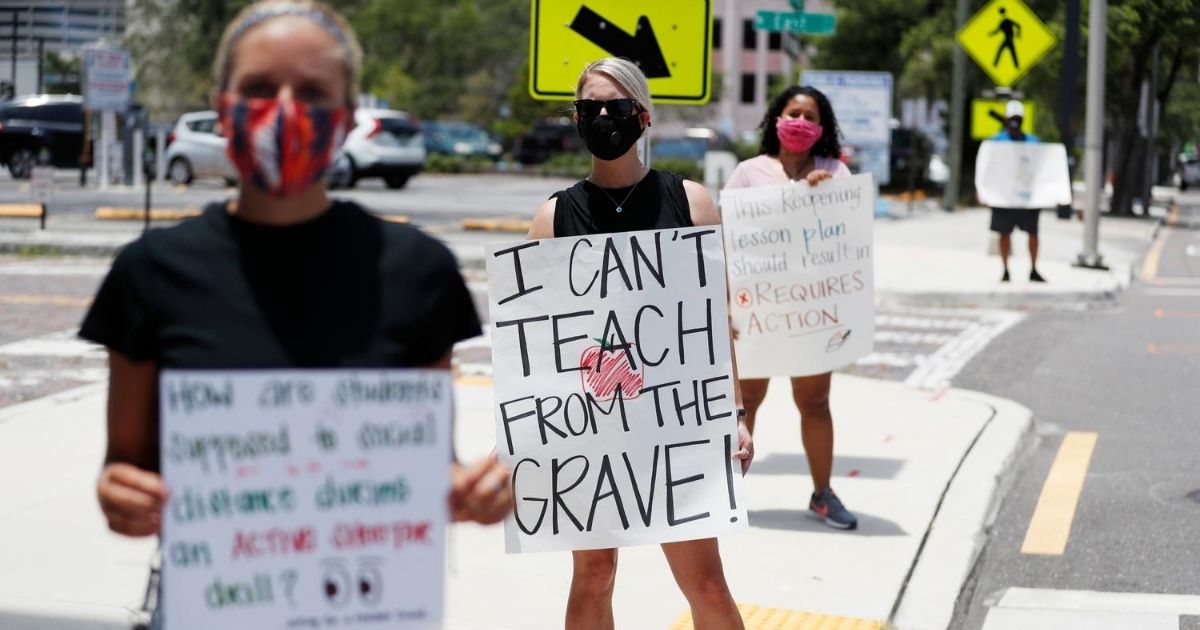
'Wary' Teachers Now Opposed to Both Online and In-Person Classes, Threaten To Strike
With public school districts nationwide beginning to cancel in-person learning for the fall semester in answer to COVID-19 transmission fears, a number of teachers unions already are moving the goalposts.
According to The New York Times, educators in the hard-hit states of Florida and California might be “wary of returning to class” this back-to-school season, but that concern hasn’t stopped them from shooting down alternatives such as virtual learning.
Widely promoted as the logical alternative to traditional learning, online video instruction was a go-to for many public institutions when coronavirus-related lockdowns first took effect in late March. Several major teachers unions now argue, however, that the practice was stressful, distracting and detrimental to learning — and they want to see their educators provided with alternatives or a reduction in labor hours this fall should virtual learning become the standard.
Railing against such requests Friday, Corey DeAngelis, the director of school choice at the Reason Foundation, a nonprofit libertarian think tank based in Los Angeles, told The Western Journal that the teachers unions’ moving of the goalposts with regard to re-opening is “almost beyond parody,” perfectly highlighting a deep need for competition in the primary education sector.
But the unions are fighting to remain closed and threatening strikes https://t.co/Drs16cIhDB
— Corey A. DeAngelis (@DeAngelisCorey) July 31, 2020
“You have the unions getting what they want in the sense that they’re pressuring state and local governments not to re-open the schools for in-person learning, and now you have them pushing the line a little further once they got what they wanted on that end,” DeAngelis said. “Now the argument has changed to be about what the remote learning is gonna look like.”
“You couldn’t make this stuff up,” he added. “They’re just pushing the ball down the line a little further.”
Presented as a primary concern among educators in the Times’ report was the potential for lessons via video conference to give way to student distractions or technical difficulties.
Cecily Myart-Cruz, president of United Teachers Los Angeles — a major union in the nation’s second-largest school district — told the outlet that she believes students will “turn off” far more quickly to live virtual lessons than they would for in-person learning. She has advocated against a traditional eight-hour school day this fall as a result.
Of the remaining concerns voiced by various unions nationwide, few pertained directly to student success or wellness.
While some advocated for at least several hours of virtual student-teacher interaction, others expressed discontent about having worked outside the hours outlined in their emergency teaching agreement this past spring to provide technical support and answer student questions.
Concerned educators introduced to a hybrid model, under which some students would attend class in-person and others would attend virtually, also were displeased, suggesting such a system would be too hectic.
“You can’t keep track of people remotely and in front of you at the same time,” said Wendy L. Doromal, president of the Orange County (Florida) Classroom Teachers Association.
Meanwhile, other teachers apparently suggested in union listening sessions that the prospect of a full day of live video lessons had left them with feelings of “anxiety about how they and their homes would look on camera during live teaching.”
“If a teacher does not feel comfortable, and the teacher is not secure in the modality, they are not going to flourish and give the best of themselves,” said Karla Hernandez-Mats, a teachers union president in Miami-Dade County.
DeAngelis told The Western Journal on Friday that this seemingly teacher-focused look at the issue of re-opening was unsurprising coming from the unions. The role of a representative organization is to look out for the interests of its members. The interests of the consumer — in this case, students — are often secondary.
As in other sectors then, libertarian- and conservative-leaning policy analysts such as DeAngelis argue that the only way to balance these occasional opposing interests is to introduce competition.
“The main problem here is the funding goes to the schools through the property tax system, regardless of what parents have to say about this,” DeAngelis said. “I believe that’s why we’re seeing different responses from the school system than we are with any other system in the economy.”
Teachers unions are now concerned about teaching from home as well because:
“Many teachers have expressed anxiety about how they and their homes would look on camera.” pic.twitter.com/bqVGa3wpJu
— Corey A. DeAngelis (@DeAngelisCorey) July 31, 2020
“You have the grocery stores re-opening. You have day care facilities re-opening and charging parents for child care services. You have amusement parks re-opening. You have retail outlets opening. So many other sectors of the economy are re-opening, and the differences in those other sectors is that families can take their money elsewhere,” the policy analyst added.
“The way that I’ve said it before is that if your local Walmart doesn’t re-open, you can take your money elsewhere. But if your school doesn’t reopen, you don’t have that same power.”
Backed in part by their education monopoly, the unions — on more than one occasion throughout the pandemic — garnered substantial media attention for high-profile threats to strike in the fall should school districts fail to meet their public health demands, and even their political ones.
These incidents in turn led DeAngelis to say the unions had “overplayed their hand.”
Political controversy and public sector strong-arming, he added, would play against them in the eyes of the American parent, and perhaps win further support for home schooling.
According to the National Home Education Research Institute, roughly 2.5 million American students in kindergarten through the 12th grade are home-schooled, with the practice apparently rising in recent years.
Recent studies conducted by EdChoice/Morning Consult and Real Clear Opinion Research indicate that 41 and 52 percent, respectively, of American parents have seen their views on home schooling improve since the start of the COVID-19 pandemic.
“If you’re going to have to watch your children each day, why not take control of their full curriculum and their schedule and just take the leap into home schooling?” DeAngelis said. “I mean, it’s pretty much like you’re having to do a lot of that already, if the school is not reopening in person. So I think a lot of families are saying, ‘Well, it’s not much different. I might as well take the jump.’
“Families are seeing that they’re doing a lot of the work or sometimes even most of the work, and the money is remaining in the government school system. They’re not getting a rebate on their property taxes, and the funding is staying in the system,” he said.
“So I think families are seeing finally they’re waking up to the fact that they’re powerless when it comes to K-12 education in the current system, and I think that this will lead to families pushing for more things like education, savings accounts, know other school choice mechanisms, such as vouchers, so that that money could follow the child to wherever they’re receiving an education, including in the home.”
Truth and Accuracy
We are committed to truth and accuracy in all of our journalism. Read our editorial standards.
Advertise with The Western Journal and reach millions of highly engaged readers, while supporting our work. Advertise Today.











